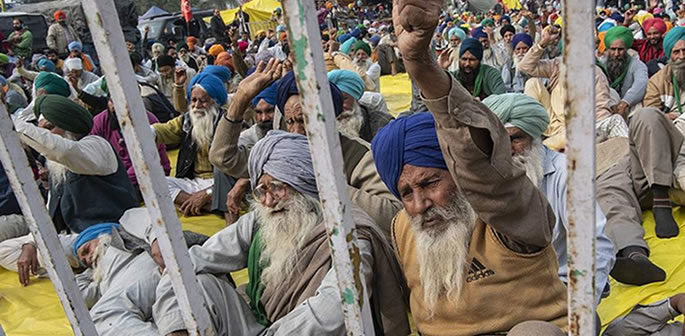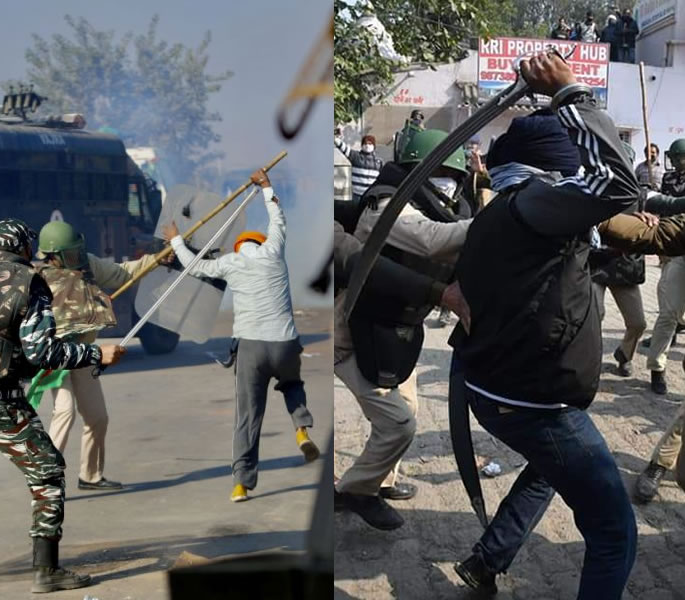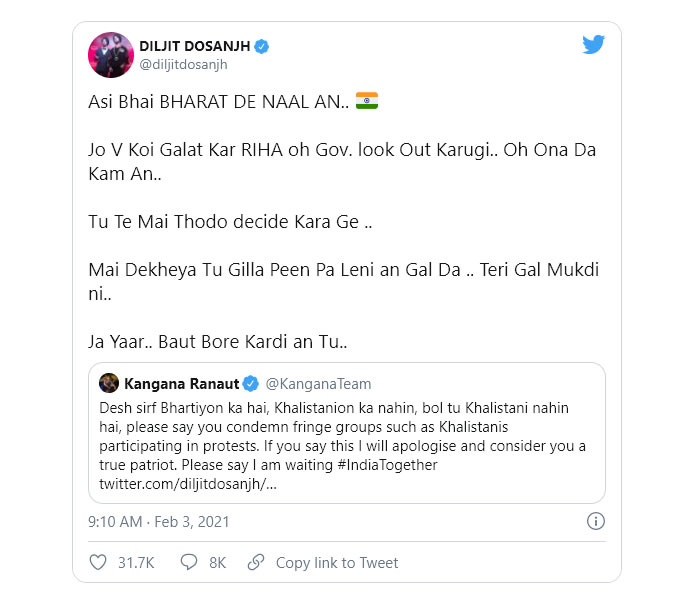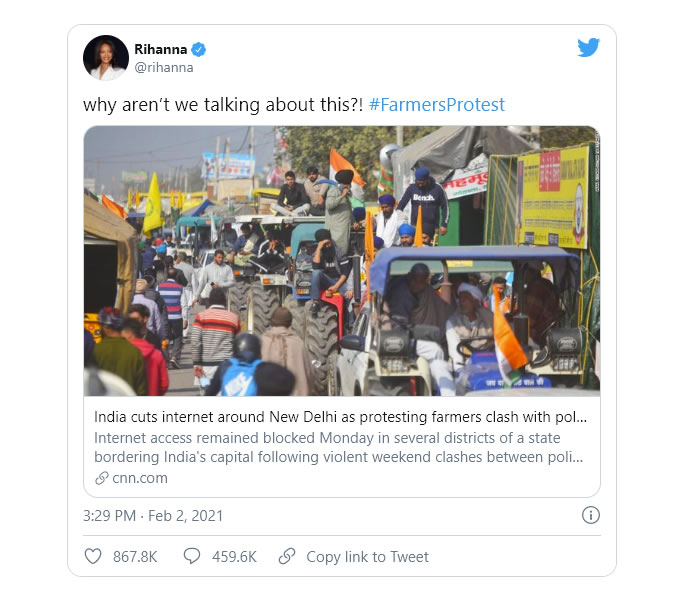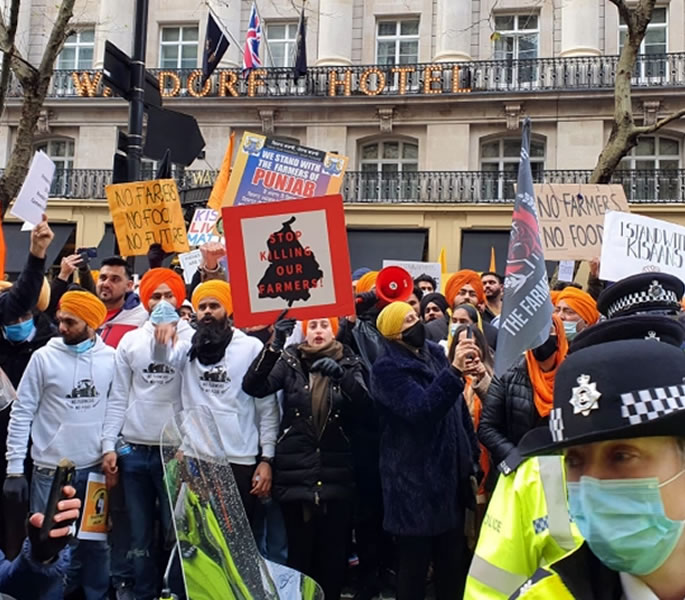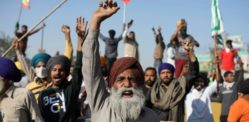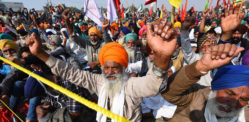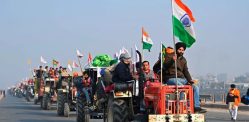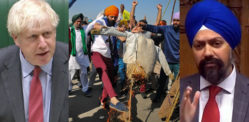the largest organised protest in human history
Since September 2020, the Indian farmers protest has been campaigning against law reforms they believe will have devastating impacts on their livelihoods.
During the protest, farmers have united from across India and its different states. Including Punjab, Haryana, Bihar and others.
Several rounds of talks between the farmer’s leaders and the Indian government have proved futile, and tensions continue to grow.
The protest has been labelled the largest organised protest in human history with lukewarm coverage around the world.
It seems to be unfolding into a humanitarian crisis, and we aim to explore why.
Farmer Discontentment with the Bills
Following news of farming law reforms in August 2020, protests began on local scales in Punjab and Haryana.
The biggest contention being a lack of consultation with the farmers before the passing of the bills.
To show their concerns regarding these amendments, farmers galvanised as a united protest and started their march towards New Delhi.
The Indian government maintain that farmer liberation and elevating the agricultural economy through private investment lie at the core of these reforms.
This is not a sentiment shared by the farmers themselves. They fear being left at the mercy of large corporations and with no safety net for their produce.
In the US and Europe too, some governments have facilitated agricultural domination by private players. Currently, around 70% of farmland across the world is controlled by a tiny 1% of farms.
Such corporate control in a country like India could be devastating. With a huge 60% of the Indian population involved in the agricultural sector, a vast number of farmers are at risk.
The sheer number of people protesting highlights the extent of this opposition. At the peak of the protests, around 250 million people were involved. To put this into perspective, that is the equivalent of 1/5th of India’s population.
Though northern India, especially the state of Punjab, is at the forefront of this movement, farmers across India have expressed solidarity with the protesters.
There have been tractor and motorcycle rallies in West Bengal, Tamil Nadu and Odisha to name a few. Protesting outside district headquarters in Gujarat and Kerala has also been reported.
On a larger scale, there has been an international uproar, especially, among the Indian diaspora related to Punjab.
With diaspora referring to populations living outside their ancestral homeland, those of especially of an Indian Punjabi background have been vocal in expressing fury at what the farmers are experiencing.
Because there is an avid connection between these families living abroad and their generational families, relatives, cousins and friends living back in their homeland.
There is a strong heritage which has a bond with agriculture and a way of life for Punjabi people living abroad.
Many Indians living abroad still own land back home which they feel is going to be affected by these bills.
Therefore, to support the protest, London, New York, Amsterdam, Melbourne and countless other cities have seen rallies and demonstrations outside embassies.
Arvi is a first-generation Punjabi from Nottingham. He has never visited India. Nevertheless, he understands the magnitude of this situation.
Speaking about his feelings on the matter, Arvi says:
“It may not seem like my direct problem – I’ve never even been to my family farm in Ludhiana. But farming is the very reason I’m living the life I am.
“It was the occupation of my grandparents, and they held their title as farmers with pride.
“Through their hard work and graft, my parents were able to build lives in the UK.
“My heritage is rooted in agriculture and this means that in their time of need, it’s my duty to stand up for the farmers.”
Generations outside India have been unified by their common aim to amplify the farmers’ voices. From a humanitarian crisis has been born this somewhat positive product.
Impact on Peaceful Protests
Freedom of expression and peaceful assembly are human rights.
However, violent crackdowns by the Indian police grow in frequency and this appears to be violating the farmers’ protests.
From the initial ‘Delhi Challo’ march, protesters were prevented entry into the capital by huge blockades. Tensions reached new heights on Republic Day on January 26, 2021.
Attempts by farmers to dismantle barricades saw police officers armed with batons and assault rifles deployed. Disturbing videos from the ground showed the use of tear gas and water cannons too.
Some protestors stormed the historic Red Fort and a small minority diverged from planned rally routes.
There are clashes being reported on both sides and flashpoints of violence being plastered on social media.
Incidents include police showing unwarranted aggression against protestors and others of protestors with weapons being waved at police, all resulting in serious injuries.
While police are following orders using the policy of regimental violence and barricades, farmers are retaliating also with the same in return due to huge agitation.
Images and videos of police beating protesters mercilessly are common on social media but so is content showing protesters doing the same vice-versa.
This is just increasingly taking the spotlight away from the real reasons for the protest and needs of real farmers suffering behind this canvas of violence.
Samyukt Kisan Morcha rejected the “anti-social elements” that had infiltrated an otherwise peaceful protest.
Farmers have attributed violent events to fringe groups, intent on disrupting the movement. In contrast, opposers of the Indian farmers protest have used the aggressive displays of the Republic Day rally to vilify the farmers.
Intensified pressure has grown on farmers to leave protesting sites.
The environment had been pretty stable, with some level of coexistence between police on duty and farmers in camps. However, stone-pelting and petrol bomb attacks have created extremely dangerous conditions at the Singhu border.
Protestors claim BJP-recruited goons are behind these, with the intention of derailing the movement. Water and electricity supplies have been cut too, depriving protestors of basic necessities.
Such media blackouts are entrenched in Indian history as a form of suppression.
In 2019, the controversial Citizenship Amendment Bill ignited widespread protests in Assam. PM Narendra Modi took to Twitter to reassure the citizens
The irony? The internet was blocked in the Assam that day. The PM found his voice suppressed, by the very blackout imposed to suppress others.
Such internet suspensions are occurring during this farmers protest, notably at the main hubs. These repressive tactics can have dire implications.
Accurate reporting of events is prevented, for on-the-ground sources are unable to communicate. Protestors cannot be contacted, their families are fearful as the safety and whereabouts of their loved ones unconfirmed.
Authorities appear to have further ramped up their oppression strategy.
On January 30, 2021, freelance journalists Mandeep Punia and Dharmendra Singh were detained by Delhi police. Videos of Mandeep being dragged by officers emerged online.
After countless calls for their release, Dharmendra Singh was released on Sunday, January 31, 2021, and Mandeep Punia was granted bail on February 3, 2021.
Speaking to reporters outside the jail, Punia said:
“It (being inside the prison) turned out to be an opportunity for me.”
“I got a chance to talk to the farmers lodged in the jail and scribbled notes on my legs. I am going to write a detailed report.”
“My work is to report from ground zero… I asked the farmers why and how they were arrested.”
Despite the tensions and sparks of violence with police, the overall mood among farmers is still very united and organised with food and supplies being made available to all at the protest points.
Ongoing immense deliveries of milk, flour and staples are all organised by the farmers themselves without any reliance on the government.
Increasing Number of Deaths
In the midst of a pandemic, mass gatherings put lives at serious risk. With their objections falling on deaf ears though, farmers feel as though there is no other choice.
Crippling farmer debt runs rife in northern Indian states. The profits of agriculture are no longer sufficient in sustaining families.
Depression rates amongst farmers creep up, likely to continue on this trajectory if their voices continue to be ignored. This protest captures the desperation of their plight.
The elderly especially should be at home in safety, yet they camp in harsh and cramped conditions.
Gruelling long-distance travel and exposure to Delhi’s sky-high pollution are only contributing to deteriorating protestor health.
As icy winds grip the capital, extreme weather has been the cause of numerous protestor deaths.
In December 2020, 76-year-old Baldev Singh sadly passed away after catching a fever. Undeterred in spirit, his son Raghuvir Singh joined the protests.
He stated:
“I have joined the protest now because I don’t want his sacrifice to go waste.”
“His last wish was to get the farm laws repealed, and I will keep demonstrating till my last breath.”
The determination of farmers can only be described as admirable. There are believed to have been over a hundred deaths, each loss of life sweeping its own tide of grief over protestors.
Families are heartbroken. Sons, daughters, siblings, parents in disbelief that the day their loved one left for the protests was the last time they would see them.
Bhavana More’s husband Ajay who was aged 32, was protesting at the Singhu border.
Mr More called her on December 7, 2020, assuring her he would return soon. The next day, he was dead. Another victim of the cold, and of the protests.
Navreet Singh, aged 27, was killed when his tractor overturned during the Republic Day rally.
Joginder Singh, who was 22-years-old, committed suicide upon his return from the Singhu border.
PM Modi is yet to address these losses of life or the protests in general. His previous claims that farmer suicides are a ‘worry for the nation’ is not being seen as a condemnation related to protest-related deaths.
Understanding the Protests Better
While there is a lot of information on social media, news reports, videos being shared; it is becoming difficult for many to really understand the Indian farmers protest, its core purpose and what it means to individuals affected by the crisis.
India is seen as the largest democracy in the world based on population. However, with the amount of conflicting information and biased information from both sides, it is difficult to ascertain what is true, real or what is not.
It is difficult to find out is really going on in the country unless you are actually there. Since, there are different political stances, opposing views, pride, fear, worry and of course, propoganda.
Therefore, to understand the protest better it is important to carefully evaluate the information coming out of India, on social media, on local and global news outlets and naturally from individuals experiencing the protest.
Fake News and Misreporting
Fake news and speculation run riot when it comes to news related to the Indian farmers protest.
NDTV journalist Ravish Kumar coined the term ‘Godi media’ to describe biased media supporting government agendas. This phrase has become popularised over the protests, indicating the extent of narrative distortion.
In attempts to portray the farmers as violent, old and unrelated videos of destruction are being circulated online.
In December 2020, a burning telephone mast was shared on Twitter, claimed to be the doing of protesting farmers.
It was later confirmed that the pole had caught fire by accident. The video was actually from 2017.
There are many reports and images which are difficult to decipher.
Many Indian journalists are finding it hard to report the reality on the ground.
Photos are easily morphed, text and dates changed and videos edited to show different angles.
Certified international organisations have people on the frontline, and are thus a primary source. Freelance journalists often report from the ground too, providing unbiased accounts of events.
Supporters of either side can easily bias how they present information in this way.
Accurate and reliable reporting from the big news outlets would offer a solution to this issue. However, the widescale coverage by the mainstream media is not on the scale that many desire.
Therefore, it can be difficult to ascertain the truth of stories, but occurrences like this just stress the importance of reliable information.
The Role of Social Media
For those who are miles away from the site of Indian farmers protest, it is easy to feel out of touch with the plea of the farmers.
For anyone with a major concern and vested interest in the protest, the role of social media plays a very fundamental and important role.
Many feel it is the only way to keep in touch and find out the latest of what is going on by following hashtags or by following specific accounts.
Be it in India or globally, it can assist greatly.
Amardeep attended the demonstration outside the High Commission of India in London. He was overwhelmed by the turnout, which was in the thousands.
Amardeep says:
“The show of unity was insane.
“Asian communities often find a way to squabble over the most trivial issues, but this was different.
“Everyone put their differences aside for the bigger cause.”
“It was social media that facilitated this. You see it on someone’s story, stick it on your own story – it reaches more and more people, like a never-ending chain.
“There was so much support for the rally online and to see it reflected in person too was a very proud moment.”
Social media platforms like Instagram have been flooded with hashtags defining the protests such as #StandWithFarmers, #isupportfarmers, #nofarmersnofood, #kisaanmazdoorektazindabaad (‘long live unity between farmers and labourers’).
They capture the millions of farmer-related posts being shared by people globally.
Social media has also illuminated the work of humanitarian organisations.
Khalsa Aid, is an example of an international NGO, which actively supports citizens of war-torn areas and disaster zones.
During the Indian farmers protests, the organisation has distributed everything from blankets and bedding to female sanitary products.
CEO Ravi Singh encouraged the use of social media to raise awareness. Especially, since the protest was not specific to any faith or background, but a human issue.
He said in a post:
“This isn’t exclusively a Sikh struggle but in fact there are Hindu farmers, Muslim farmers, farmers from UP, farmers from Haryana, farmers from Bihar, farmers from Rajasthan and just farmers all over India from different backgrounds which are all united against this Farmers Bill.”
Ravi also highlighted the use of social media to spread lies and propaganda against the real purpose of the protest – Indian farmers.
Encouraging the sharing of important coverage on social media Ravi said:
“You might think “well this isn’t going to do much” but just imagine, imagine that you use it and then 100 people then use it, then a 100 people from there use it – as you can see it gets around then it comes up as trending allowing for even further coverage.”
Celebrity Voices
Celebrities have also used their social media platforms to show their support for their side of the debate.
Celebrity YouTuber Lily Singh, British boxer Amir Khan, celebrity chef Tony Singh, Mia Khalifa and many other stars from the west have shown solidarity for the cause.
Punjabi singer and actor Diljit Dosanjh was one of the first to show his solidarity for the quest of the farmers. Many others like Gippy Grewal, Jazzy B (who visited farmers), Harbhajan Maan, Mika Singh and Ranjit Bawa in support as well.
However, Bollywood actress Kangana Ranaut is one example of a person who has been vocal against the protest and has been involved in social media spats. She believes the agenda of the protest in anti-nationalist.
She has been in a long engaged Twitter spat with Diljit, claiming he is a ‘Khalistani’ and the agenda of the farmers’ protest is divisive to India.
One major celebrity fraternity which has been notably quiet about the farmers protest is Bollywood.
Priyanka Chopra and Dharmendra have come out in solidarity. After international stars showed support, Salman Khan did say on February 5, 2021:
“The right thing should be done. The most correct thing should be done.
“The most noble thing should be done.”
However, veteran actor Nasureedin Shah has openly shown his support in a video interview slamming other stars not showing their support for farmers, saying in Hindi:
“I feel that this farmers protest will grow and the everyday person will give it support. This will happen.
“Staying quiet is only complimenting the oppressor is what I think.”
“And the legendary and highly-acclaimed people from our film industry who are staying quiet seems as if they are afraid of incurring a loss
“But hey [you big stars], when you have earnt so much wealth that seven generations can sit and eat comfortably, how much can you lose?”
International stars like Rihanna have raised a question about the protest via a Tweet but have come under fire for being external to an issue which is internal.
There have been claims she was $2m paid to do the tweet.
Subsequently, a photo of her holding a flag at a cricket ground showed it to be of that of Pakistan was then fact-checked as being fake by a number of publications including The Quint, Boom Live and AFP.
However, the photo was morphed and circulated on social media to project her as anti-India. The real image was of her holding a West Indies flag in 2019.
Another example is an image of US Vice President Kamala Harris extending her support to the protestors emerged. It was fake. As was the alleged Winter 2020 National Geographic cover of a turbaned farmer.
Support for farmers has also come from Hollywood, with actor, activist and mother, Susan Sarandon showing solidarity for the plight.
Therefore, it must not be forgotten that social media and fake news come hand-in-hand.
So, scepticism is the best way to approach any story unless you definitely know it is not fake or propaganda from either side of the protest.
Raising Awareness for Everyone
Kate recently learnt of the protests due to the relentless sharing of events by her friend Jas. She says:
“I’m actually astonished at the extent of these protests.
With the exception of my Punjabi friends on social media, I had no clue what was going on.
“I have so much respect for my friends.
Knowing that the tragic experiences of their community are so repressed, they are doing an incredible job at sharing information.
“This isn’t just their problem though. As humans, we should all sympathise with the farmers’ plight.”
“Now I’ve learnt about what’s going on, I’m going to be raising as much awareness as I can.”
Educating just one new person can be the catalyst for more informed awareness despite what your position is on the protest.
Support of Countries
The support of countries for a crisis and protest of this size always add weight to such a cause.
However, diplomatic relations between India and other countries will always play a major role to correlate to any kind of intervention.
The UK is home to around 700,000 Punjabis. Many of them will have generational connections back home.
They will be deeply concerned for those at the centre of the protests, diaspora hope for some form of intervention by their country.
It is difficult to forget PM Boris Johnson’s blunder in the House of Commons when he was questioned on the Indian farmers protest by Slough MP Tan Dhesi.
Instead of having awareness about the issue, he provided an unrelated response regarding India/Pakistan tensions.
In addition to Punjabi MP’s like Preet Gill and Tan Dhesi, others have spoken up.
Several UK residents have emailed their local MPs, conveying anxiety regarding the human right violations and abuse in the protests.
This resulted in over 100 MPs and Lords signing a cross-party letter requesting PM Johnson to raise hopes of a speedy resolution with PM Modi.
Dominic Raab, the Foreign Secretary has been urged by Sikh groups to start a dialogue with the UN and Indian government.
They highlight as a comparison of how active the UK is addressing China’s suppression of protests.
Countries are limited in their action. Indeed, there is no jurisdiction forcing any nation to involve itself with the internal affairs of another.
Ongoing problems like the impact of Covid-19 and other pressing local matters for global governments are always going to be their priority.
Akash’s uncle is a farmer in Amritsar. He has been protesting at the border since November 2020. Akash says:
“Of course, my whole family worries about my uncle’s welfare. For all the protestors’ welfare.
“I’ve written to my MP expressing my concerns, and I know so many other people have too.”
“I really hope Boris will understand how anxious the protests have left us and is encouraged to take action.
“Maybe he can take inspiration from other countries with large Punjabi populations. I know Canada has been really vocal on the situation.”
Ravi is referring to Canadian Burnaby South’s MP Jagmeet Singh, who called on PM Trudeau to condemn the violence brewing in the protests.
However, the Indian government does not take well to unwanted input by external parties commenting on internal affairs.
Following Trudeau’s remarks in defence of peaceful protest, ministry spokesperson Anurag Srivastava described his comments as ‘ill-informed’ and ‘unwarranted’.
There are many Indians as well who feel the same as well about any external politician, activist or celebrity making any comments on the protest and how it should be handled.
Action ultimately lies in the hands of the Indian government, but increased pressure from other countries and their people should at least increase the awareness within India that the world is watching.
The ripples of this movement are felt worldwide and will only grow.
Infuriation increases as a country labelled as the world’s largest democracy fails to address its unhappy farmers and their future livelihoods.
The cost incurred so far has been heavy in terms of lives lost, families broken, livelihoods obliterated and the creation of unwanted tension.
Before this crisis spirals further out of control, which is humanitarian because of the risk to humans who happen to be farmers, it is hoped that a swift resolution can be found which is acceptable to Indian farmer and government.



















































